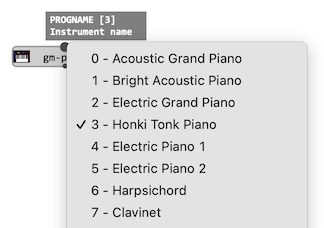OM# Documentation
Important MIDI Concepts
This page introduces some important concepts and terms used in MIDI features and documentation.
→ See more in the official MIDI specification. There’s alo many other simplified versions of it all over the internet!
Events
MIDI is all about sending and receiving messages called events: a MIDI event is a data structure including a type (e.g. KeyOn, KeyOff, continuous controller, program change, etc.), a channel number, and a sequence of values.
When a musical structure is played in OM#, it is ususally converted into a sequence of MIDI messages/events, which are scheduled and sent to a synthesizer (see Sending MIDI). Saving as MIDI also stores this sequence of events in a file.
Notes
There is actually no such thing as a “MIDI note”: A note is defined by the succession of a KeyOn and a KeyOff events, which correspond to the activation and release of a given “key” (as on a piano keyboard).
The values of KeyOn and KeyOff events are:
- a key number, which determines a pitch of the note. In the MIDI convention, 60 is the middle-C, 61 is C#, 62 is D, etc.
- a velocity (value beween 0 and 127).
The time span between a KeyOn and a KeyOff event of a given pitch defines the duration of the note.
Sometimes
KeyOffevents are not used in MIDI files, and replaced byKeyOnevents with velocity = 0.
Notecan occasionally appear as a type of event in OM# (seeMIDIEVENT). This is a convenience shorthand, internally converted into a pair ofKeyOn-KeyOffevents.
Channels
Most MIDI events apply to a specific channel. The MIDI standard limits the number of channels to 16.
For events that are not channel-specific, the channel number is ignored.
Channel 10 is usually reserved from drums.
Control Change
Continuous controllers are settings that can be sent to a MIDI synthesizer, usually through messages of type ControlChange. ControlChange messages apply to specific MIDI channels. The type of control as well as the setting value are given as message parameters (or “values”), both given in the range 0-127.
Program Change
Program Change messages (or ProgChange) assign a specific instrument (or “program”) to a given channel.
The “General MIDI” standard defines a list of 128 timbres and sound which can be used to choose the desired sound on compatible synthesizers.
The
gm-programbox in OM# enables retrieving the program number corresponding to this list:
Pitch Bend
Pitch Bend is a special type of MIDI message, specifying a pitch alteration for a given channel, usually in the range of ± 2 semitones. Pitch bend values are specified with values in the range of 0-16383 (14 bits), with the middle range (8192) meaning no alteration.
OM# utility function
mc-to-pitcwheelconverts a given amount of midicents into the adequate pitch bend value.
Important: PitchBend applies to all events on a given channel. It is not possible to change the pitchbend for a single MIDI note or key.
Bending the pitch of specific MIDI channels is used in OM# in order to render microintervals. To do so, notes in quarter- or eight-tones must be set to play in dedicated channels. See Microinterval Settings for details.
Tracks
The Standard MIDI File format allows organizing MIDI events in “tracks”: a useful concept to separate voices, or instruments in scores or DAWs in general.
There exist two main formats for MIDI files :
- Format “0” contains a single track containing all MIDI events.
- Format “1” may contain separated tracks tracks.
There can be any number of tracks, and events of any channels can be included in any track. The track is however just a structural info which is not transmitted to MIDI synthesizers. A control change event sent to a given channel, for instance, will have an effect on the synthesizer’s settings for this channel independently of the track where this event was assigned.
Track #0 is often dedicated to tempo and time signature events, which apply to all tracks.
